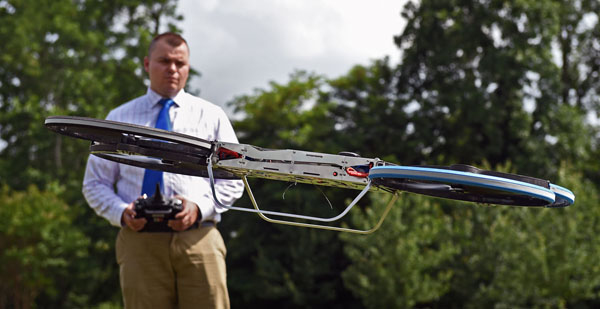

JULY 16, 2015 4:37 PM • CARRIE WELLS THE BALTIMORE SUN
Inside a lab in this city outside Baltimore, a small 3-D printer bleeps, passing black plastic through a needle to slowly build the feet of a mannequin named Buster.
Once assembled, Buster will ride a drone that’s a one-third-scale model of a “Hoverbike” — essentially a variation on a quadcopter — being developed by engineers here and in the United Kingdom. In just a few years, they imagine, soldiers will fly Hoverbikes over treacherous terrain while consumers could glide around their backyards.
The bike, reminiscent of the speeder bikes from the “Star Wars” film “Return of the Jedi,” was first developed by Chris Malloy in his garage in Australia. In June, Malloy Aeronautics announced it had partnered with Belcamp-based SURVICE Engineering Co. to develop the bike for the U.S. military under a research and development contract with the U.S. Army Research Laboratory.
Malloy teamed with SURVICE due to its experience dealing with the Department of Defense and for its proximity to U.S. military facilities. Founded in 1981, SURVICE built its business providing services to improve combat system safety, survivability and effectiveness.
Grant Stapleton, Malloy Aeronautics’ sales director, said the Hoverbike’s developers hear about the “Star Wars” resemblance often.
“We enjoy science fiction, we all appreciate it,” he said, laughing. “I can’t speak for Chris (Malloy), but it wasn’t our intention originally.”
The full-sized Hoverbike model — currently housed at the Malloy labs outside London but coming to the United States later this year — can fly carrying up to 200 pounds, its developers say.

A workable military version would need to carry two to four times that weight — 400 to 800 pounds, or a soldier plus his or her gear.
The Malloy and SURVICE engineers believe they can create a workable model in three to five years, and a commercial version for civilian use also is in the works.
Timothy Vong, a project coordinator with the Army Research Laboratory protection division, said in an email that the Hoverbike passed a recent initial feasibility study and that the military would help fine-tune it once a prototype was delivered in the next few years.
The Hoverbike “has shown the potential to unburden soldiers while increasing their capabilities regardless of the conditions, in manned and/or unmanned field operations,” he wrote. “Additional possibilities for the concept could include aiding in communication, reconnaissance, protection, sensing danger or lighten the load soldiers carry.”
The Malloy and SURVICE engineers envision soldiers riding the Hoverbike to their destination, then using it for unmanned surveillance once the soldier is on the ground. It also could transport supplies without a soldier on board.
The Hoverbike has sparked some skepticism over its developers’ claims.
“Every once in a while someone comes up with a claim that we can come up with a better way of transporting troops in the field, and the military says they want something that can help with areas that are impassable, terrain that’s not normally crossable,” said Tim Brown, senior fellow at the think tank GlobalSecurity.org. “So they come up with these systems and this stuff almost never survives.”
To be useful for the military, Brown said, it would have to meet a need that couldn’t be filled by a helicopter, all-terrain or other type of vehicle. He said it also would face stiff competition for shrinking federal dollars in a Pentagon budget littered with programs that “already have defenders.”
Stapleton estimated a commercial version would cost about the same as an SUV or executive car, comparing the commercial and military versions to the difference between Humvees and Hummers.
The Hoverbike developers now are experimenting with motorbike handlebars.
“This was designed from the ground up to have someone on it,” Butkiewicz said. The Hoverbike’s potential ability to carry soldiers over any terrain is what intrigued the Army.
“The Army is interested in disruptive-technology solutions that would keep soldiers away from ground threats,” Vong said. “The Hoverbike is one of many potential solutions the Army is exploring. It is not being evaluated as a replacement for a vehicle … but this kind of technology could serve as an alternative.”
Source: Daily Sun. (Sunday, August 30, 2015) Forget the future - hoverbike could be a reality soon. C1&2.
![]() Copyright 2001 Northern Arizona
University, ALL RIGHTS RESERVED
Copyright 2001 Northern Arizona
University, ALL RIGHTS RESERVED